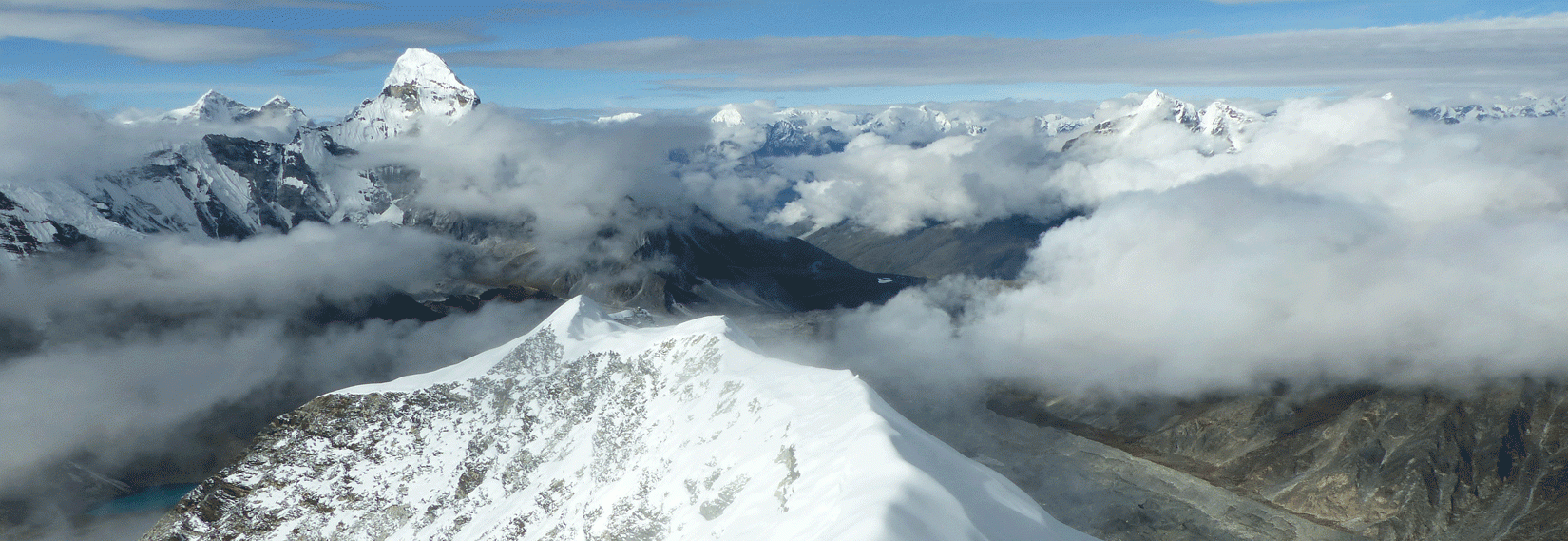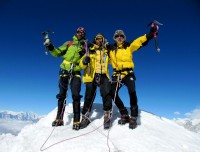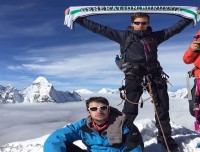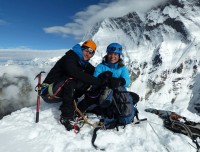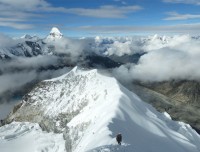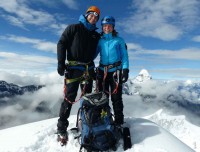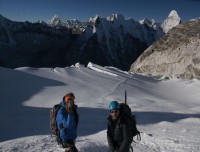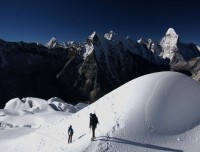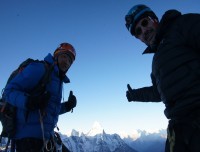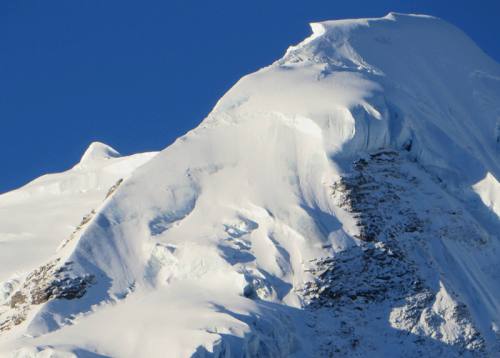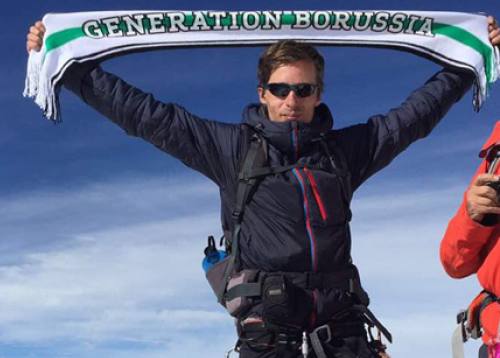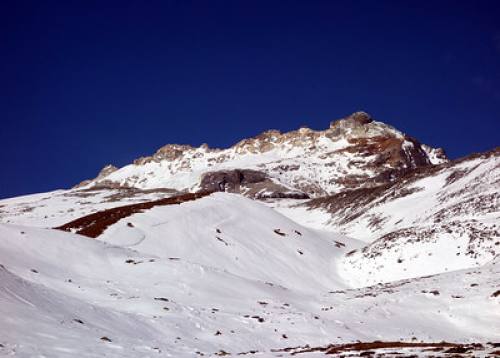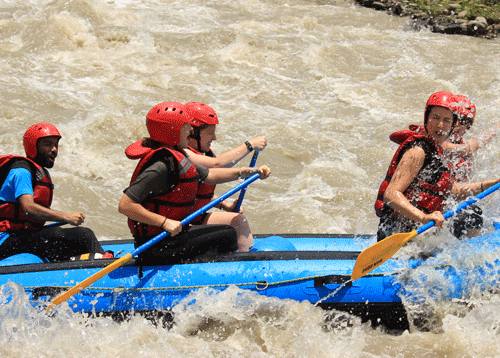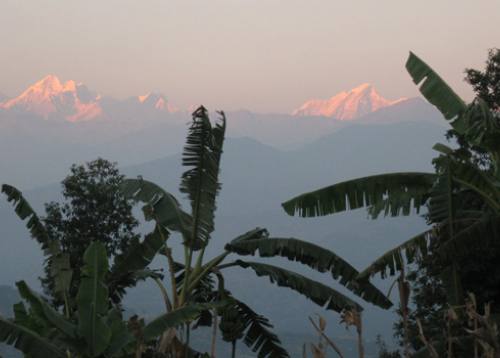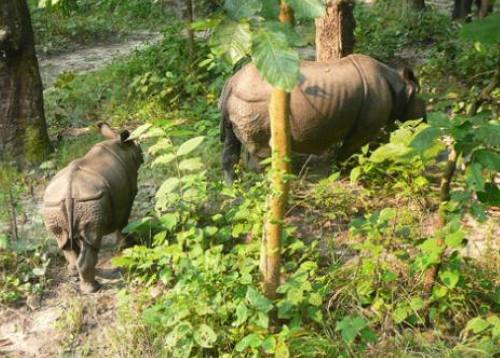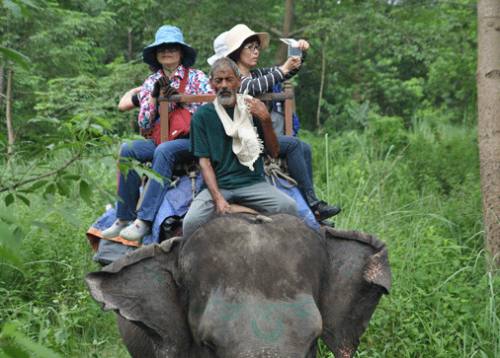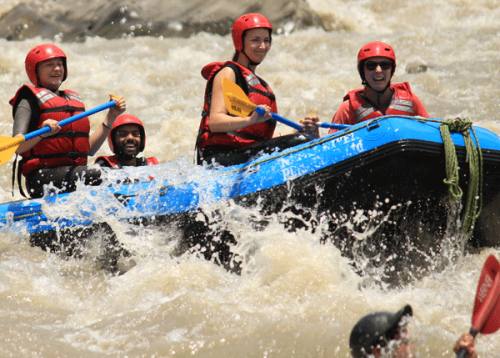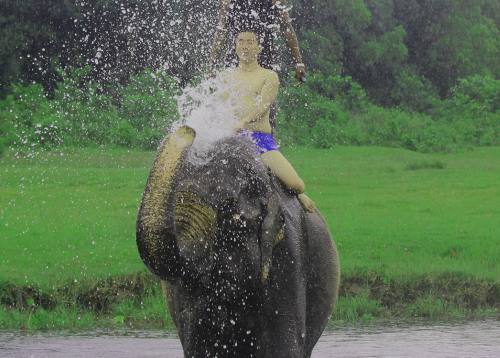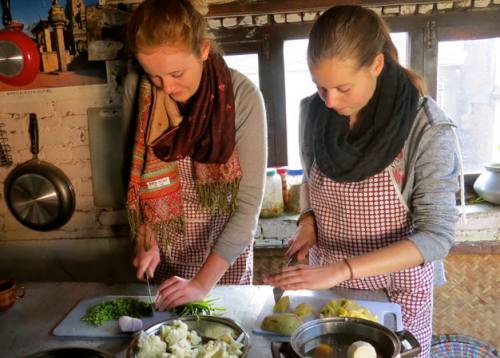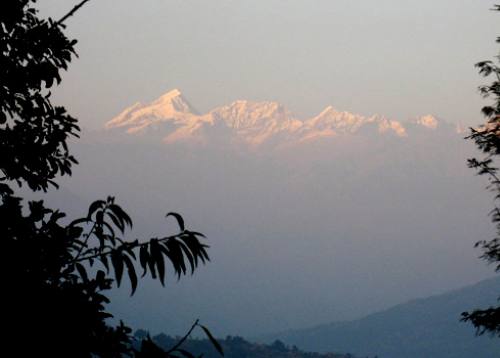Island Peak Climbing
- Trip Duration16 Days
- Trip GradeModerate to Strenuous
- Max. Altitude6,189m / 20,305ft
- Cost Starting FromContact Us
- Destination: Nepal
- Meals: Breakfast, Lunch and Dinner
- Transportation: Private Transport + Flight
- Accommodation: Lodge + Camping
- Max. Altitude: 6,189m / 20,305ft
- Min. Group Size: 02 Minimum - 10 Maximum
Highlights
- The panoramic views of snow capped mountains in our flight to/from Lukla
- Insight into the Sherpa culture and their lifestyle
- Great practice for climbing Everest
- Spectacular views of the Himalayan giants; Everest, Lhotse, Makalu
- Island Peak Summit Base Camp (6189m/20306ft)
Island Peak climbing 6189m is the most attempted and succeed climbing (trekking peak) over 6000m in Nepal Himalaya. The professional climber would like to starts their carrier by summit this peak before attempt 7000m or 8000m and more.The peak seen from above Dingboche the mountain does indeed resemble an island in a sea of ice. The peak is locally known as Imje Tse. This peak involves one steep and exposed 100 m ice or snow climb, otherwise its non-technical snow climb is enjoyable and offers some of the most striking scenery in the Khumbu. The mountain itself is really an extension of the South ridge of Lhotse Shar and is separated from it by a small col.
Island Peak Climbing, the caravan route follow the Everest base Camp trekking trail till Dingboache and separate towards right. Chukung is the last village before the Island peak base camp. This peak offers a beautiful view to Mt. Everest, Lhotse, Nuptse, Barunche, Amadablam and many other peaks.Your climbing guide will give you a refreshment training in Chukung before head to Base camp about using a gears properly and safety in climbing. Some people would like to attempt from Base camp as well as but to give you a feeling of success we put high camp and do a final attempt. After successful summit, return to Chukung and trek back to Lukla and fly to Kathmandu.
Itinerary
Day 1Arrival Kathmandu (1,300m/4,428ft)
Upon our arrival at the Tribhuwan International Airport in Kathmandu, Mount Trails representative will pick us up and take you to your hotel. After checking in, trip preparation and also to meet our crew. In the evening there will be a welcome dinner where we will be able to enjoy authentic Nepali cuisine. Overnight in Kathmandu. Included meals: Dinner
Day 2Fly to Lukla (2,800m/9,184ft) then trek to Phakding (2,652m/8,700ft): 40 min flight, 3-4 hours trek
After breakfast, we take an early morning flight to Lukla. After flying above the breathtaking green and white mountains, we reach Tenzing-Hillary Airport at Lukla. This is one of the most beautiful air routes in the world culminating in a landing on a hillside surrounded by high mountains. Upon our arrival at Lukla, we meet the rest of our crew members. Next, we begin our trek through the prosperous village of Lukla to Phakding. To assist in acclimatization, we only have a short hike today. However, if interested in additional activities, we can take a side trip to a nearby monastery. Overnight in Phakding. Included meals: Breakfast Lunch Dinner
Day 3Phakding to Namche Bazaar (3,440m/11,283ft): 5-6 hours
After breakfast we walk through beautiful pine forests and then along Dudh Koshi River ending our nature-filled journey at Namche Bazaar. After walking for almost over an hour, we come across the glistening Mt. Thamserku (6,608m) on our right and also experience the serenity of pine, fir and juniper forests throughout our journey. If the weather is clear, we may even catch a glimpse of Mt. Everest peering over the Lhotse-Nuptse ridge. We continue walking until we reach the entrance to Sagarmatha National Park, Namche Bazaar, the gateway to Mt. Everest and main trading centre of this region. This day we cross five suspension bridges, the last one also known as the Hillary Bridge being the highest. It is an uphill walk from Hillary Bridge to Namche Bazaar. Overnight in Namche Bazaar. Included meals:Breakfast Lunch Dinner
Day 4Namche Bazaar (3,440 m/11,283 ft): Acclimatization Day
Today is set aside for acclimatization. Health experts recommend that instead of being idle we stay active and move around even during the rest day. We can either stroll around Namche’s quaint villages and get acquainted with the Sherpas and their rich culture, or we can hike up to the Everest View Hotel and enjoy an up-close view of the mighty Everest. While in the Namche village or upon returning from the hike to the Everest View Hotel, trekkers may also visit the local museum containing exhibits displaying the area’s native flora and fauna as well as the history of the Mount Everest region.
For trekkers who want to hike for a little longer, a hike to Khumjung village (5-6 hours) may also be an option. In the village we can visit the Edmund Hillary School and Khumjung Monastery (a monastery famous for housing the head of the Yeti!). Overnight in Namche Bazaar.Included meals:Breakfast Lunch Dinner
Day 5Namche Bazaar to Tengboche (3,870m/12,694ft) 5- 6 hours
After breakfast, we trek towards Tengboche. It is an easy walk from Namche to Phunki. Upon reaching Phunki, we ascend towards Tengboche, a village that houses the very famous Tengboche monastery which is the largest monastery of the Everest region. Located amidst the Sagarmatha National Park (a UNESCO World Heritage Site of "outstanding universal value”), it is draped with the panoramic 360-degree view of the Himalayas, including Mt. Everest, Nuptse, Lhotse, Ama Dablam and Thamserku and is also the biggest monastery in the Khumbu region. We visit the monastery the same day at around 3 p.m. to witness a religious ceremony. Overnight in Tengboche. Included meals:Breakfast Lunch Dinner
Day 6Tengboche to Dingboche (4,360 m/14,300 ft): 5 to 6 hours
With the Himalayas as its backdrop, the monastery in Tengboche is in a perfect location to enjoy the beautiful Himalayan landscape. We visit the monastery in the morning and take pictures of the amazing landscape. Then we begin our trek by walking through lush forests of birch, conifers and rhododendrons on an easy path. This picturesque trail then dips down to Debuche, crossing the Imja River before climbing up to Pangboche (We can either walk in the upper or lower Pangboche trails). We are most likely to choose the upper Pangboche trails as it provides more pristine view of the Himalayas. We also visit the Pangboche monastery. From here onwards, the walk is fairly moderate as we enter the Imja Valley. The valley gradually unfolds as we approach the confluence of the Lobuche River. We descend into the river and begin the climb up to Dingboche. On arrival at Dingboche, we are greeted by a beautiful array of fields enclosed by stone walls to protect barley, buckwheat and potatoes from the cold wind and grazing animals. Overnight in Dingboche. Included meals:Breakfast Lunch Dinner
Day 7Dingboche to Chhukung (4,730m/15,518ft): 3-4 hours
Dingboche is a summer settlement and here the great peaks of Ama Dablam, the ridge of Nuptse-Lhotse, Tawache and Chalotse surround us. We begin today’s trek to Chhukung by walking through stone-walled fields, Imja Khola valley before walking in glacier moraines. On our walk, we will be surrounded by Lhotse and Ama Dablam mountains. Later, beyond Bibre village we see Island Peak soaring above us. The trail ahead is intersected by icy streams. We reach Chhukung, a small settlement in about half an hour from Bibre. From here, directly across the valley is the fantastic Ama Dablam and the Amphu Labsa mountains. Overnight in Chhukung. Included meals:Breakfast Lunch Dinner
Day 8Acclimatization day - Climb Chhukung Ri (5,546m) and trek back to Chhukung: 3 – 4 hours
Today is another day set aside for acclimatization. Climbing Chhukung Ri should help our body adjust to the high altitude. Chhukung Ri is a peak located directly above the Chhukung village. The climb to Chhukung Ri involves some easy scrambling near the summit. From the top, we can look directly across the valley for a fantastic view of Ama Dablam and Amphu Labsa peaks. We descend back to Chhukung to spend the night. Included meals:Breakfast Lunch Dinner
Day 9Chhukung to Island Peak Base camp (5,200m/17,060ft): 3-4 hours
The trek to Island Peak Base Camp is on a fairly steep trail. First, we climb south then turn east to the main line of the valley. We then walk on a winding path below the southern flank of the moraine from the Lhotse Glacier. Next, we continue walking on a pleasant trail along a streamside. The route to the Amphu Lapcha lies to the southeast. A crisscross route through the Imja and Lhotse glacier moraines leads to a wide valley flanking the SW side of Island Peak. Overnight at Island Peak Base Camp. Included meals:Breakfast Lunch Dinner
Day 10Pre-Climb training on Island Peak Base Cam
We begin our pre-climb training today after breakfast. Our guides will provide training on peak climbing techniques and the proper ways of using climbing gears such as the ice axe, climbing boots and crampons, harness, ascender, etc. The training will also include using ropes to go up and down. Although it is not mandatory to have prior training for Island Peak climbing, we strongly believe that some training experience will boost your confidence and climbing skills to increase the chances of scaling the summit as well as to fully enjoy the experience. Usually we will be climbing on rock surface for up to around 5770m. After that, we climb on ice and use ropes when necessary. However, the use of the rope and the length depends upon the season and the crevasses. We can spend the rest of the day hiking to high camp and back or resting for the next day’s climb. Overnight at the base camp. Included meals:Breakfast Lunch Dinner
Day 11Island Peak Base Camp to Island Peak Summit (6,189m/20,305ft), back to base camp: 10-12 hours
We wake up early today at around 12 to 1 am and have our breakfast before beginning our climb. It is important we reach the summit before noon because in the afternoon the strong winds in the highlands might become a barrier for a successful summit. The trail moves up beyond the base camp for several hundred meters before striking off the steep hillside. Initially sandy, the path soon turns to grass before becoming boulder strewn. As we climb up the hill, we will see that the slope narrows and the trail enters a steep rock channel. We climb the rock gully. This is not difficult, but there are several short rock steps to climb before we emerge on the right side of the gully. The route then follows a ridgeline, which leads to an exhilarating and exposed traverse onto the snout of the summit glacier. The guides will fix a rope when required. A steep snow slope leads us onto the summit ridge. Both fixed rope and man rope will be used during the climb for safety. We use fix rope after successfully climbing on rock. The length of the rope will usually be of 350m. However, the length depends on the time of the season and the crevasses
There are two newly formed crevasses which are approximately 3 and 4 meters long. We will be using ladders to cross them. After enjoying the summit views, and taking pictures, we descend all the way to Island Peak Base Camp where some of our crew is waiting for us. We celebrate on our successful Island Peak climb. Included meals:Breakfast Lunch Dinner
Day 12Island Peak Base Camp to Pangboche (3,985m/13,074ft) 5-6 hours
Today’s walk will be a much easier as we descend to the lower altitudes. Following the same route back through the wide valley of Khumbu Khola, we pass through the beautiful Sherpa villages Orsho and Shomare. We can also take a different trail to visit the Gompa in Upper Pangboche, which is believed to be the oldest in the Khumbu region or take the regular trail to reach Pangboche. Pangboche is a scenic village surrounded by Everest to its north, Ama Dablam, Thamserku, and Kangtaiga to the east, the Kongde range to the south and the Imja Tse River flowing through the wide fertile valley. Included meals:Breakfast Lunch Dinner
Day 13Pangboche to Namche Bazaar: 4-5 hours
From Pangboche we retrace our steps down to the Imja Khola and up through the forest to Tengboche. If interested, we can also visit nuns at the Tengboche monastery. After lunch at Tengboche, we continue through the hillside blanketed by rhododendron and juniper trees. After crossing the bridge over the Dudh Koshi River, our trail follows the Dudh Koshi gorge descending rapidly through the pine forests before reaching Sansa. We keep a lookout for wildlife such as mountain goats, snow leopards, colorful pheasants, etc., while passing through the forest. After passing a chorten, we reach the army camp at Namche Bazaar. Overnight in Namche Bazaar. Included meals:Breakfast Dinner
Day 14Trek back from Namche Bazaar to Lukla: 6-7 hours
The trail descends steeply downward so we need to walk cautiously as our shaky legs continuously battle the rocky terrain. After crossing the suspension bridges over the fast flowing Dudh Koshi and its tributaries, the trail becomes more level and natural. After our arrival in Lukla, we stretch those sore legs and recall the experiences of the last couple of weeks. Overnight in Lukla. Included meals:Breakfast
Day 15Fly back to Kathmandu
We catch an early morning flight to Kathmandu after our long mountain journey. After reaching Kathmandu, we can take a rest or do some souvenir shopping. If we want to explore any other areas of Kathmandu, we may do that today. Our guides can help you with both souvenirs shopping or sightseeing. There will be a farewell dinner in the evening to celebrate the climbers’ successful summit of the Island peak. Overnight in Kathmandu. Included meals: Breakfast Dinner
Day 16Final departure
Your adventure in Nepal comes to an end today! Included meals: Breakfast
Trip Cost Details
Cost Include
- Airport pickups and drops off by private vehicle
- Accommodation in Kathmandu with breakfast basis
- Teahouse accommodation during the trek and tented accommodation during the climb as per itinerary
- All meals (breakfast, lunch and dinner) during the trek and climb with tea / coffee
- All ground transportation on a comfortable private vehicle as per the itinerary
- Domestic flights (Kathmandu- Lukla -Kathmandu) with all taxes
- English speaking, trained and experienced trekking guide(leader), climbing guide (leader) and assistant guides and Porter service (1 porter between two trekkers)
- All expenses for all field crews (including their salary, insurance, equipment, domestic airfare, food and accommodation )
- Sleeping bag (to be returned after trip completion)
- Mount Trails’s duffel bag, and trekking map
- All necessary paper work; trekking permits and Island Peak climbing permit
- Good quality tents and kitchen utensils for camping
- Medical kit (carried by your guide)
- All government and local taxes and service charges
Cost Exclude
- Personal expenses (phone calls, internet, laundry, bar bills, battery recharge, extra porters, bottle or boiled water, shower, etc.)
- Personal climbing equipment
- Excess baggage charges (if you have more than 15 kg luggage, cargo charge is around Nrs 150 per kg)
- Extra night accommodation in Kathmandu because of early arrival, late departure, early return from mountain (due to any reason) than the scheduled itinerary
- Altitude chamber (PAC) or oxygen
- Lunch and dinner in Kathmandu (and also in the case of early return from mountain than the scheduled itinerary)
- Travel and rescue insurance
- Optional trips and sightseeing if extended
- Tips for guides and porters
- Services not listed in the ‘What Is Included’ section
Trip Map
Client Reviews
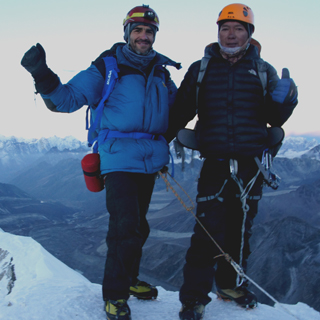
Excellent Service from Durga - Mount Trails
We had a very impressive ascent of Island Peak, everything works well.Many thanks to Durga, for the organization, including the start and the end of our trip in Kathmandu in the lovely hotel Yala Peak and Yala Peak Café, where we felt like home. Absolute recommendable. We came back!!!!
Useful Info
What Makes This Trip Different?
Mount Trails believe in the quality services with great vlaue to our guests. Your safety and satisfaction is our concern. We are a team of professional, experienced, well trained and licensed local guides who knows the destination much better than others. Not only this but also we give benefits the local communities and helps to conserve natural resources which reduced in costs and consumption.
Mount Trails Trekking and Adventures works for social causes with some non-profit organization http://letsgocool.org concerned with environmental conservation and preservation includes Orphan children who need better education and the better life. We are supporting for the cause with some of our profits to a certain organization so that we can make their life better and bring happiness in thier life. We believe that education and healthy children make more stable and better future of Nepal. For donation, Sponsorship or any kind of Voluntourism, please contact to our orginization [email protected]
Trip Note
Meals
Breakfast, Lunch & Dinner are included in the package. Your guide will suggest delicious, hygienic and each place special food during your trip. Mountain restaurant owner prefer not to order many dishes and waste food as they would like to cater more trekkers with limited food before run off stuck. Its a week or more days hard work to porters and caravans to bring food to these places. During the trek you will usually have breakfast and dinner at the same Lodge, lunch will be eaten at one of the trail side restaurants en-route.
Accommodation
we will have a Tea House ( Mountain Lodge ) while one trekking. Private rooms are available in most of Tea Houses, except for high altitudes ones where it will be just dormitories or room with shared bathroom which is fairly basic. The rooms are spare with twin beds and very little additional furniture. Blankets are generally provided at Tea House accommodaiton. There is a large dining room-cum-lounge, warmed by the bukhara stove (an iron cylinder) fitted with a chimney duct, in which a log fire is lighted. There is normally no electric lighting in the rooms unless the village has hydroelectric power. The dining room usually has solar lighting system or also have electricity for charging mobile phones and cameras , there may be a small charge for this.
Drinking water
we can get mineral water and boiled water during the trek upon additional cost. We discourage the purchase of Mineral water and bottled water while on the Trek as plastic bottles aredifficult to dispose off and have become an environmental problem so we would suggest you to have chlorine/Iodine treated water during the trek in himalayas.
Route Map
Mount Trails offers you complementary route maps.
What to take
This is a very active trip so pack as lightly as possible. Unnecessary luggage or things, you can leave in Kathmandu Hotel and its absolutely free of cost. We provide one porter between two trekkers to carry your gear luggage. Porter put your bags in a duffel bag that we will provide which will be very safe. The maximum weight, porters are allowed to carry is about 20 KG per trekker.
Important to note
- Please kindly read the equipment checklist section for additional details what you need to bring for the trek. You will need to bring a comfortable day pack to carry the things that you will need during the day, recommended ( a waist strap or (better) a padded waist belt ).
- The weather is subject to change in high altitude so layered clothing and good gears is recommended throughout the year.
